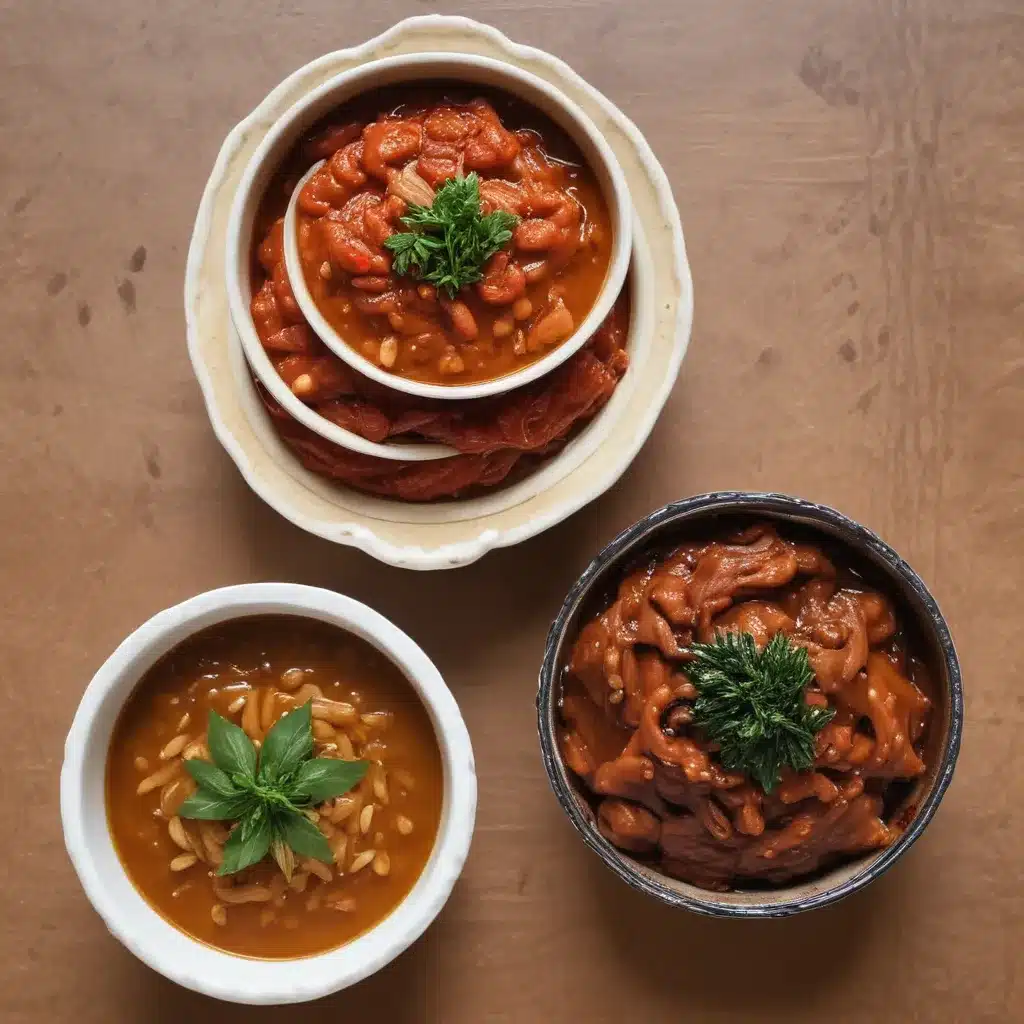
Unlocking the Secrets of Korean Cuisine: A Flavorful Journey
As a self-proclaimed Korean cuisine enthusiast, I’ve always been intrigued by the rich and complex flavors that Korean dishes bring to the table. But amongst the myriad of ingredients that make up this vibrant culinary landscape, two ingredients have always stood out to me as the unsung heroes: doenjang and gochujang.
The Umami Power of Doenjang
Doenjang, the mighty soybean paste, is the foundation upon which so many beloved Korean dishes are built. It’s the key to unlocking that deep, savory umami flavor that makes Korean food so irresistible. But what exactly is doenjang, and how does it work its magic?
Well, my friends, let me tell you a tale of fermentation and patience. You see, the making of doenjang is a labor of love, a process that can take months to complete. It all starts with the humble soybean, which is first boiled, then mixed with a special type of fungus called Aspergillus oryzae. This mixture is then left to ferment and age for anywhere from 3 to 12 months, depending on the desired flavor profile.
As the soybeans break down, they release a symphony of amino acids and peptides that create that signature umami taste. But the real magic happens when the doenjang is combined with other ingredients, like garlic, onions, and chili peppers. The result is a complex, multilayered flavor that can elevate even the simplest of dishes.
I remember the first time I tried a homemade doenjang stew, or doenjang jjigae. The rich, salty broth enveloped my senses, and with each bite, I discovered new depths of flavor. It was as if the doenjang had unlocked a secret door to the heart of Korean cuisine.
The Fiery Embrace of Gochujang
But doenjang is not the only star in the Korean pantry – its spicy counterpart, gochujang, also deserves its time in the spotlight. Gochujang, a fermented chili paste, is the backbone of many beloved Korean dishes, from bulgogi to tteokbokki.
What makes gochujang so special, you ask? Well, it’s a complex blend of red chili peppers, glutinous rice, fermented soybeans, and a touch of sweetness. The fermentation process, which can take anywhere from 6 months to 5 years, transforms the flavors, creating a unique balance of heat, sweetness, and umami.
I’ll never forget the first time I tried gochujang-marinated grilled pork belly, or samgyeopsal. The combination of the charred, succulent meat and the fiery, complex gochujang sauce was like a symphony of flavors in my mouth. It was a revelation, a testament to the versatility and power of this humble ingredient.
But gochujang’s uses go far beyond just marinating meats. It can also be used as a condiment, a seasoning, or even a base for stews and braises. I’ve even seen it used in unexpected places, like in a delightful gochujang-glazed salmon dish that I had the pleasure of trying.
The Yin and Yang of Doenjang and Gochujang
Now, you might be wondering, what’s the difference between these two Korean superstars? Well, my friends, it’s all about the yin and yang, the balance of opposites.
Doenjang, with its earthy, umami-rich flavor, is the yin to gochujang’s fiery yang. While doenjang provides the foundation, gochujang adds the punch of heat and depth of flavor. Together, they create a harmonious dance, elevating each other and bringing out the best in the dishes they’re used in.
In fact, the two are often used in tandem, as in the case of the beloved Korean barbecue dipping sauce, ssamjang. This thick, spicy-sweet paste is a perfect marriage of doenjang and gochujang, with a splash of garlic, onion, and sesame oil for good measure.
I can still vividly remember the first time I tried ssamjang, wrapped in a crisp lettuce leaf with a piece of charred pork belly and a sliver of raw garlic. The flavors and textures were a revelation, a symphony of contrasts that left me craving more.
Incorporating Doenjang and Gochujang into Your Cooking
Now, I know what you’re thinking – “Wow, these ingredients sound amazing, but how do I even begin to use them?” Fear not, my friends, for I have some tips and tricks up my sleeve.
First and foremost, start with the basics. Doenjang can be used as a seasoning, a base for stews and braises, or even as a marinade for meats. Simply add a tablespoon or two to your dish, and let the umami magic happen.
Gochujang, on the other hand, is a versatile chameleon. Use it as a glaze for roasted vegetables, mix it into a creamy dip, or even incorporate it into your baking (yes, you read that right – gochujang-infused brownies are a revelation!).
And don’t forget about the power of combining the two. Whip up a batch of ssamjang for your next Korean barbecue feast, or use both doenjang and gochujang to create a complex and flavorful stew or braise.
The key is to experiment, to play with the flavors, and to have fun in the kitchen. After all, that’s what cooking is all about, right? So go forth, my friends, and let the flavors of doenjang and gochujang transport you to the vibrant and delicious world of Korean cuisine.
References
[1] https://mykoreankitchen.com/ssamjang/
[2] https://www.reddit.com/r/AskCulinary/comments/828jbv/gochujang_vs_doubanjiang/
[3] https://chowdivine.com/ssamjang-gochujang-doenjang-sauce-for-wraps/
[4] https://www.maangchi.com/recipe/ssamjang
[5] https://www.reddit.com/r/KoreanFood/comments/14fb0g5/confused_what_is_the_difference_between_gochujang/
[6] https://www.koreanbapsang.com/how-to-make-gochujang/
[7] https://adventureswiththepig.wordpress.com/2011/10/05/gochujang-pork/
[8] http://thedomesticgoddesswannabe.com/2013/07/beef-doenjang-jjigae-%EB%90%9C%EC%9E%A5-%EC%B0%8C%EA%B0%9C-korean-soy-bean-paste-stew/
